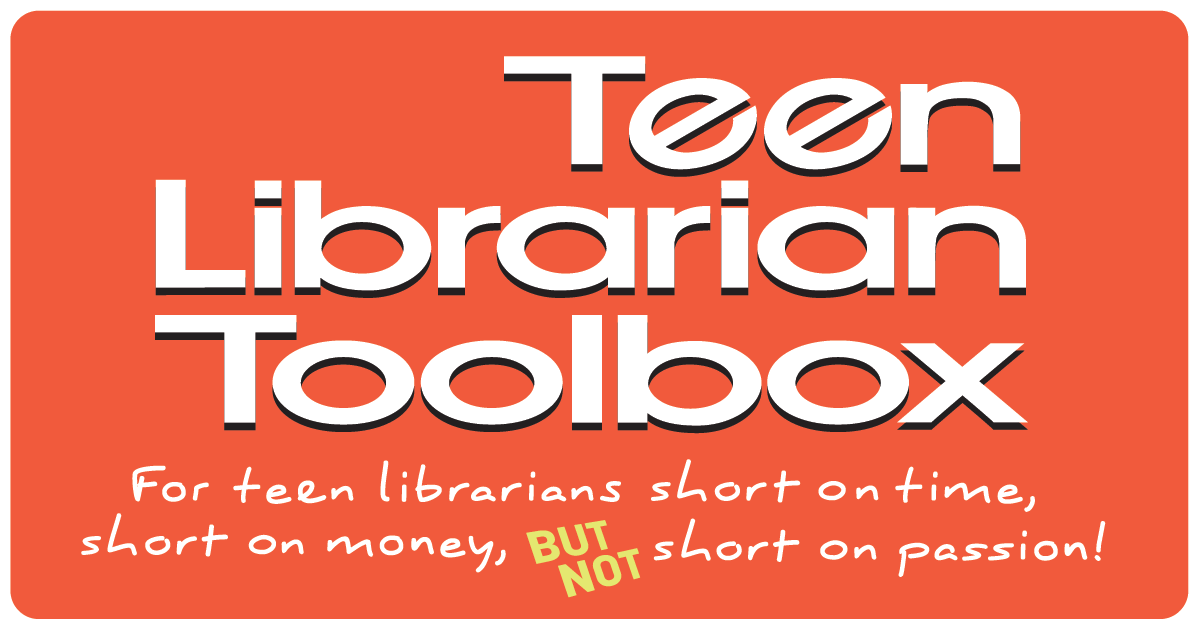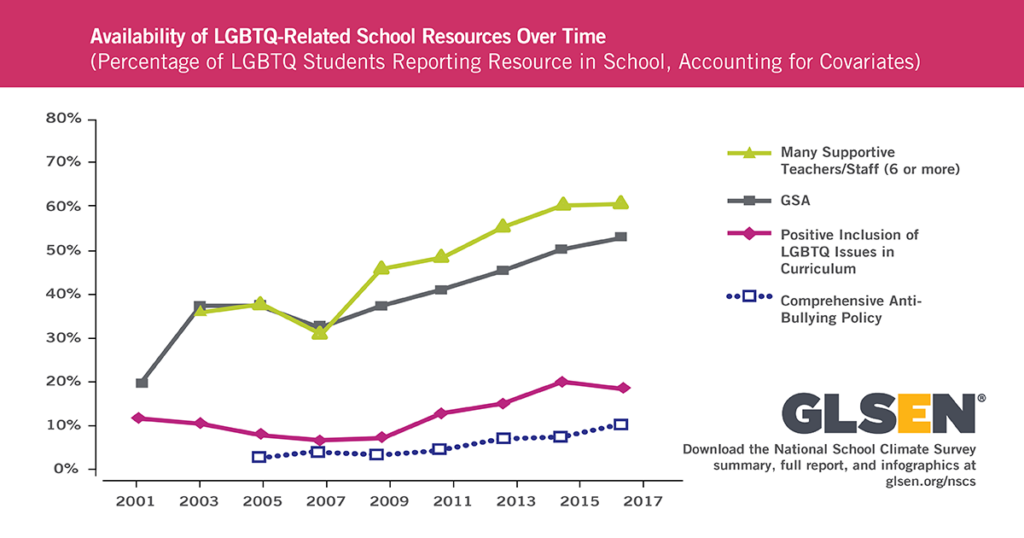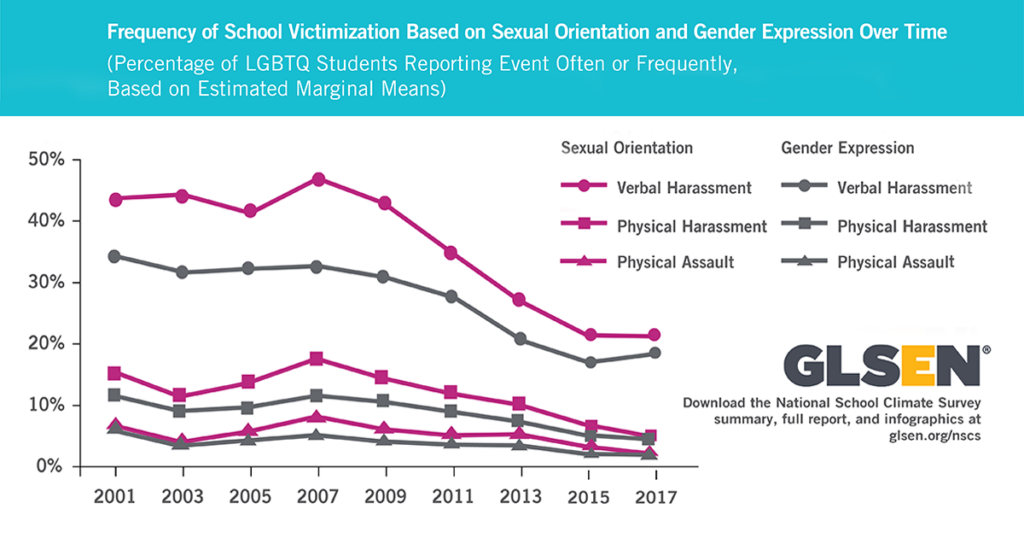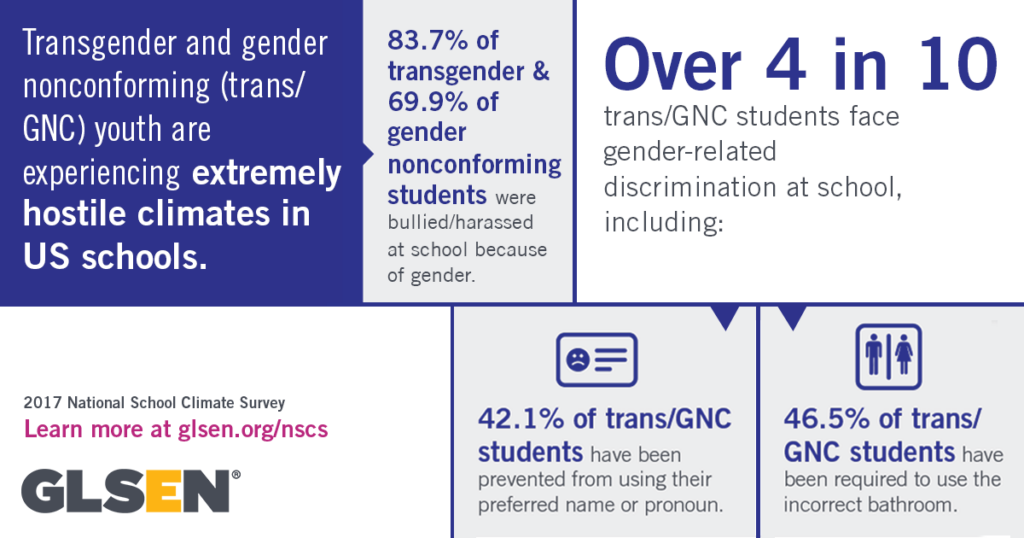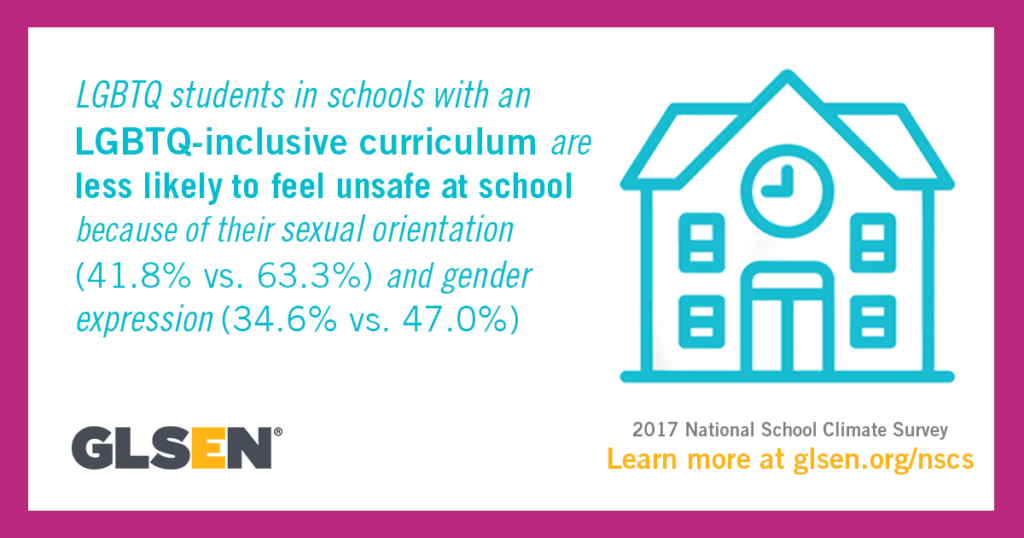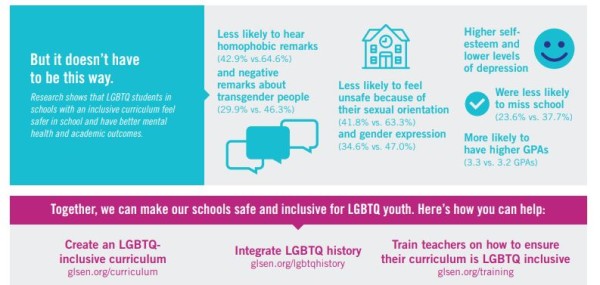National School Climate Survey results about LGBTQ students’ experiences in school
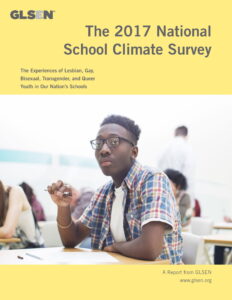 GLSEN, the Gay, Lesbian and Straight Education Network, released its biennial National School Climate Survey, which documents the experiences of lesbian, gay, bisexual, transgender, and queer youth in schools from across the country, in the fall 2018. The 2015 survey results showed slight improvements for LGBTQ kids in schools. This newest report shows that progress in schools has slowed and transgender and gender-nonconforming students face more hostile environments than before.
GLSEN, the Gay, Lesbian and Straight Education Network, released its biennial National School Climate Survey, which documents the experiences of lesbian, gay, bisexual, transgender, and queer youth in schools from across the country, in the fall 2018. The 2015 survey results showed slight improvements for LGBTQ kids in schools. This newest report shows that progress in schools has slowed and transgender and gender-nonconforming students face more hostile environments than before.
196 page report (which is available as a PDF) looks at discrimination, harassment, assault, biased language, school resources and support, and more, and examines how these factors affect educational performance, safety, and mental health of LGBTQ teens. The report is filled with statistics, charts, and graphs that drive home the point that LGBTQ students face a lot of opposition at school and frequently don’t feel safe or supported. Being knowledgeable of the potential struggles and understanding where they (and you!) can go to find useful resources (books, websites, helplines, etc) is a major step in the right direction.
ADVERTISEMENT
ADVERTISEMENT
As GLSEN reports, “The survey has consistently indicated that specific school-based supports are related to a safer and more inclusive school climate, including: supportive educators, LGBTQ-inclusive curriculum, inclusive and supportive policies, and supportive student clubs, such as Gay-Straight Alliances or Gender and Sexuality Alliances (GSAs).).” For the first time, “This installment of GLSEN’s National School Climate Survey also includes insights on LGBTQ-inclusive sex education, student activism, parent advocacy, experiences of LGBTQ students with disabilities, and experiences of LGBTQ immigrant students.” (See here for the media release, where this quote came from, for more quick facts.)
This report should be required reading for anyone who works with students of all ages.
“This report should serve as an alarm bell for advocates and a call to action for anyone who cares about students’ wellbeing,” said Eliza Byard, GLSEN Executive Director.
The following data is taken from the survey results. Though the report in quite long, it’s important reading. The report does offer summaries of survey points. All infographics are from GLSEN and available to download and share. They also have posters you can download for your classroom or library, too. The summary points from this report includes offensive slurs.
Findings of the 2017 National School Climate Survey include:
Anti-LGBTQ Remarks at School
• Almost all LGBTQ students (98.5%) heard the word “gay” used in a negative way often or frequently at school.
• 95.3% of LGBTQ students heard homophobic slurs such as “fag” or “dyke” at school.
• 94% of LGBTQ students heard negative remarks about gender expression at school.
• 87.4% of LGBTQ students heard negative remarks specifically about transgender people (e.g., “tranny” or “he/she”)
• 56.6% of students reported hearing homophobic remarks from their teachers or other school staff, and 71.0% of students reported hearing negative remarks about gender expression from teachers or other school staff.
School Safety, Harassment, and Assault at School
• Close to 9 in 10 (87.3%) LGBTQ students were harassed or assaulted at school.
• Sexual orientation and gender expression were the most common reasons LGBTQ students were harassed or assaulted at school.
• Nearly three quarters of students reported being verbally harassed at school because of their sexual orientation (70.1% ); more than half (59.1%) were verbally harassed because of their gender expression.
• Over a quarter of students (28.9%) reported being physically harassed at school because of their sexual orientation; 24.4% were physically harassed because of their gender expression.
• 12.4% of students reported being physically assaulted at school in the past year because of their sexual orientation, 11.2% because of gender expression, and 10% because of gender.
• 48.7% of students reported experiencing some form of electronic harassment (“cyberbullying”) in the past year.
• Over half of students (57.3%) were sexually harassed at school in past year.
The high incidence of harassment and assault is exacerbated by school staff who rarely intervene on behalf of LGBT students.
55.3% of students who were harassed or assaulted at school did not report these incidents to school staff.
• The most common reasons that LGBTQ students did not report incidents of victimization to school staff were doubts that effective intervention would occur, and fears that reporting would make the situation worse.
• 60.4% of students who had reported incidents of victimization to school staff said that staff did nothing or told them to ignore it.
School Climate by Personal Demographics
• Pansexual students experienced a more hostile school climate than students of other sexual orientations.
• Transgender students experienced a more hostile school climate than all other students. Genderqueer students and those with other nonbinary gender identities experienced a more hostile school climate than cisgender LGBQ students.
• Cisgender students whose gender expression did not align to traditional gender norms had worse school experiences than LGBQ cisgender students with more “traditional” gender expression.
• Native American/American Indian/Alaska Native students were more likely than other racial/ethnic groups to experience anti-LGBTQ victimization and discrimination.
• White students were less likely than all other racial/ethnic groups to feel unsafe or experience victimization because of their racial/ethnic identity.
The report goes on to discuss:
*absenteeism (“LGBTQ students were more than three times as likely to have missed school in the past month because they felt unsafe or uncomfortable if they had experienced LGBTQ-related discrimination in their school.”)
*academic achievement (“Over half of LGBTQ students (59.8%) explicitly reported a hostile school climate as being factor in their decision or doubts about finishing high school. In particular, students noted issues with harassment, unsupportive peers or educators, and gendered school policies/practices, such as restrictions on which bathroom they are allowed to use”)
*psychological well-being (“Previous research has shown that being harassed or assaulted at school may have a negative impact on students’ mental health and self-esteem. Given that LGBTQ students face an increased likelihood for experiencing harassment and assault in school, it is especially important to examine how these experiences relate to their well-being.”)
ADVERTISEMENT
ADVERTISEMENT
Additionally, it looks at discriminatory policies, discriminatory discipline, restrictions, and prohibitions regarding public displays of affection, attending dances, forming a GSA, writing about LGBTQ topics, etc. It breaks the data down by race, ethnicity, school type, location, region, and more.
GLSEN offers many recommendations for turning these statistics around, such as giving students more access to LGBTQ-related information (literature, history, etc), forming GSA groups, providing professional development to increase the number of supportive teachers and staff, ensuring school policies are not discriminatory, having anti-bullying and harassment policies that make it clear that they provide safety for LGBTQ students, and teaching an inclusive curriculum.
LGBTQ students experienced a safer, more positive school environment when:
– Their school had a Gay-Straight Alliance (GSA) or Gender and Sexuality Alliance (GSA) or similar student club.
– They were taught positive representations of LGBT people, history, and events through their school curriculum.
– They had supportive school staff who frequently intervened in biased remarks and effectively responded to reports of harassment and assault
– Their school had an anti-bullying/harassment policy that specifically included protections based on sexual orientation and gender identity/expression.
– Transgender/gender nonconforming students in schools with official policies or guidelines to support trans/GNC students had more positive school experience, including less discrimination and more positive school belonging.
Previously at TLT:
Many posts for collection development and ways to support and affirm LGBTQIA+ students can be found by searching the tag LGBTQIA+ on the blog.
Also check out:
The Human Rights Campaign’s Welcoming Schools Project, which “is one of the few LGBT and gender-inclusive programs in the country that has a K-5 focus with resources to help elementary schools and educators address bias-based bullying—including anti-LGBT slurs and gender put-downs.”
From their site: GLSEN, the Gay, Lesbian & Straight Education Network, is the leading national education organization focused on ensuring safe and affirming schools for all students. Established in 1990, GLSEN envisions a world in which every child learns to respect and accept all people, regardless of sexual orientation or gender identity/expression. GLSEN seeks to develop school climates where difference is valued for the positive contribution it makes to creating a more vibrant and diverse community. For information on GLSEN’s research, educational resources, public policy advocacy, student organizing programs and educator training initiatives, visit www.glsen.org.
Filed under: Advocacy
About Amanda MacGregor
Amanda MacGregor works in an elementary library, loves dogs, and can be found on Twitter @CiteSomething.
ADVERTISEMENT
ADVERTISEMENT
SLJ Blog Network
2024 Books from Pura Belpré Winners
In Memorium: The Great Étienne Delessert Passes Away
Winnie-The-Pooh | Review
Parsing Religion in Public Schools
ADVERTISEMENT

